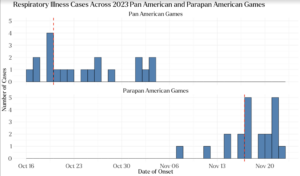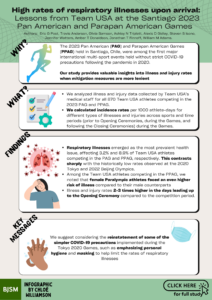Authors: Eric G Post, Travis Anderson, Olivia Samson, Ashley N Triplett, Alexis D Gidley, Steven S Isono, Jennifer Watters, Amber T Donaldson, Jonathan T Finnoff, William M Adams.
Why is this study important?
The 2023 Pan American and Parapan American Games held in Santiago, Chile, were among the first major international multi-sport events held without strict COVID-19 precautions following the start of the global pandemic in March 2020. Our study provides valuable insights into illness and injury rates when mitigation measures are more lenient, which can be used to inform strategies related to preparations for future international events, such as the Olympic and Paralympic Games.
How did the study go about this?
We analyzed illness and injury data collected by Team USA’s medical staff for all 870 Team USA athletes competing in the 2023 Pan American Games (PAG) and Parapan American Games (PPAG). We calculated incidence rates per 1000 athlete-days for different types of illnesses and injuries across sports and time periods (prior to Opening Ceremonies, during the Games, and following the Closing Ceremonies) during the Games.
What did the study find?
Respiratory illnesses emerged as the most prevalent health issue, affecting 3.2% and 8.9% of Team USA athletes competing in the PAG and PPAG, respectively. This marks a return to pre-pandemic levels, contrasting sharply with the historically low rates observed at the 2020 Tokyo and 2022 Beijing Olympics. Another striking finding was the disparity in illness rates between PAG and PPAG athletes, with the latter 2.5 times more likely to fall ill. Further, among the Team USA athletes competing in the PPAG, we noted that female Paralympic athletes faced an even higher risk of illness compared to their male counterparts. Lastly, we also noticed a significant temporal pattern, with illness and injury rates 2-3 times higher in the days leading up to the Opening Ceremony compared to the competition period. One aspect of this temporal pattern is presented in the plot below, showing respiratory illness cases across the dates of the PAG and PPAG. The red dashed lines indicate the Opening Ceremony dates, demonstrating the relatively high number of respiratory illness cases reported during the early stages of both the PAG and PPAG.

What are the key take-home points?
We suggest considering the reinstatement of some of the simpler COVID-19 precautions implemented during the Tokyo 2020 Games, such as emphasizing personal hygiene and masking to help limit the rates of respiratory illnesses. Given the elevated risks we observed in the pre-Opening Ceremony period, we advocate for additional preventive measures during this time, potentially including enhanced travel precautions and adjusted training protocols. Environmental factors also warrant close attention, particularly when athletes are traveling between hemispheres, as these can worsen respiratory symptoms due to allergens in the air. Lastly, our findings showing increased illness risk among Paralympic athletes, especially females, highlights the need for further research to 1) understand the risk factors associated with increased incidence in this population and 2) develop targeted interventions for this group. By applying these lessons, we believe medical teams and sports organizations can work towards creating safer and healthier environments for athletes competing in international competitions. While completely eliminating risks is unrealistic, our findings suggest that thoughtful, data-driven preparation can significantly contribute to protecting athlete health and optimizing performance.
